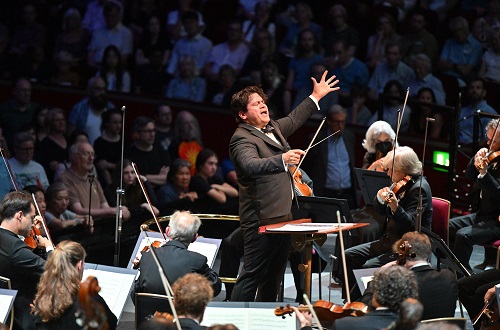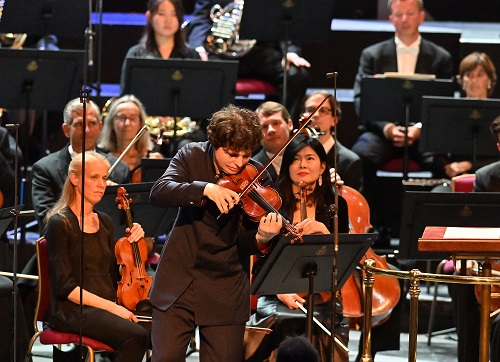
 United Kingdom BBC Proms 2022 [18], Prom 46 – Mendelssohn, Dvořák, Brahms: Augustin Hadelich (violin), WDR Symphony Orchestra Cologne / Cristian Măcelaru (conductor). Royal Albert Hall, London, 21.8.2022. (CS)
United Kingdom BBC Proms 2022 [18], Prom 46 – Mendelssohn, Dvořák, Brahms: Augustin Hadelich (violin), WDR Symphony Orchestra Cologne / Cristian Măcelaru (conductor). Royal Albert Hall, London, 21.8.2022. (CS)

Mendelssohn – Overture, ‘The Hebrides’, Op.26 (‘Fingal’s Cave’)
Dvořák – Violin Concerto in A minor, Op.53
Brahms – Symphony No.3 in F major, Op.90
Alongside live audiences, big symphonies, large choirs, amateur singers and standing promenaders, visiting international orchestras were a pandemic casualty during the 2020 and 2021 BBC Proms seasons, and while British orchestras have dominated the 2022 season thus far, the return of musicians from Europe and beyond has been one of the pleasures of this year. The visit by the Ukrainian Freedom Orchestra at the end of July, and recent performances by the Oslo Philharmonic under its new Chief Conductor Klaus Makëlä and the Vienna Radio Symphony Orchestra conducted by Marin Alsop, were followed on Sunday evening by the welcome return to the Royal Albert Hall of the Cologne-based WDR Symphony Orchestra and their Chief Conductor Cristian Măcelaru to present a programme of Romantic musical landscapes and journeys.
The WDR Symphony Orchestra have become principally known for their performances of contemporary music, so this programme of ‘safe Romantic classics’ wasn’t their usual fare. And, there were signs that it might not be quite their cup of tea, in a rather atmosphere-less account of Mendelssohn’s Hebrides Overture which struggled to capture the bleak beauty of the Scottish islands that affected the composer so extraordinarily during his visit to the Highlands in August 1829. The very large string forces seemed to prohibit the free-flowing movement of not only the opening section, with its oscillating rolls and surges, but also the broader, fluid progression between the contrasting sections of what is essentially a tone poem.
The shifts in the opening bars from major to minor and back again – reflecting the ever-changing movements of the sea and colours of sky as the weather fluctuates between sunshine and shadow in the blink of an eye – did not quite cast their usual magic, and while the dynamic contrasts and swells were meticulously observed, and rhythms were taut and precise, the overall effect was of a pictorial montage of a seascape, but not one which we were really travelling through. The cellos’ second theme was elegant but didn’t push forward and swell – it was almost as if Măcelaru wanted to smooth the waters. There was some sense of the magnitude of the storm that Mendelssohn experience on his trip out to Staffa, but not really of its menace, or of the vastness of the seascape. The tranquillity of the clarinets’ reprise of the second subject was expressive, however, as Măcelaru held the tempo back for a moment of serenity, then allowed the music to rush forward again with renewed spirit.
The orchestra were more at home in Brahms’ Third Symphony. In October 1883, the composer’s friend, Antonín Dvořák, visited him in Vienna, following Brahms’ sojourn in Wiesbaden, and in a letter to his publisher Dvořák related, ‘At my request to hear something of his new symphony, he was immediately forthcoming and played its first and last movements for me. I say without exaggerating that this work surpasses his first two symphonies; if not, perhaps, in grandeur and powerful conception – then certainly in – beauty. […] What magnificent melodies there are for the finding!” Certainly, there were beautiful melodies here, but the rich orchestral colours and hypnotic rhythmic and metrical flexibility did not always impress in the way that they should in the outer movements, and on this occasion, it was the two middle movements that were the most engaging. The Andante had a lovely calm, and there was some fine clarinet and bassoon playing here. And, the bittersweet waltz of the Poco allegretto had a fittingly wistful feeling and captured something of Brahms’s tragic mode. It’s unusual for this symphony to close a concert, given its subdued ending, but Măcelaru sustained the tranquil mood in the orchestral encore, the last of Dvořák’s Legends Op.59, and the effect was persuasive and comforting.

This was Augustin Hadelich’s evening, though. The large audience – one of the fullest I’ve seen this season – gave the violinist a tremendous welcome to the RAH, and he looked truly relaxed and delighted to be there. He is going to be Artist-in-Residence with the WDR Symphony Orchestra Cologne during the coming season, and lucky them! This was a fantastically engaging and uplifting performance of Dvořák’s Violin Concerto – an opera, lied, poem, folk song and rustic dance all rolled into one gorgeous outpouring. It told a story – a mesmerising one. The quasi-recitative opening statements glistened with intensity and balanced breadth and sweetness, the up-bow conclusions to the rhetoric surging to the heel with steely strength and weight, and commanding attention. From these first statements, Hadelich held the audience rapt as he unfolded Dvořák’s narrative, like a Pied Piper relishing every twist in the tale, each as absorbing as the last, absolutely compelling his listeners. The WDR Symphony Orchestra Cologne matched Hadelich’s blend of vitality and tenderness, and Măcelaru crafted some fine instrumental textures, letting the delicate woodwind gestures speak with as much power as the tutti assertions. It helped, I think, that the string sections were slightly reduced in size for the Concerto.
In the opening movement, Hadelich sometimes pushed forwards, nudging the ‘ma non troppo’ indication aside, but he was never anything but absolutely precise, as virtuosic and elegant expression alternated. Dvořák’s double-stops and octaves – there are lots of the latter in this Concerto – were ever warm and glowing, and the climaxes gleamed with such beauty that it took one’s breath away. And from such heights, Hadelich retreated to the most gentle pianissimos, his use of rubato in the dolce theme at the centre of the first movement especially captivating. But, before one knew it, he was off again, skipping playfully, mordants smiling, string crossings sparkling, octaves commanding.
The transition into the Adagio, ma non troppo was brilliantly shaped, the first horn warmly complementing the recollection of those opening improvisations, and a G-string melody of poetry and poignancy – echoed by the woodwind – ushering in a nostalgic Bohemian vein. If one’s heart didn’t melt during the slow movement, then one must have been one of Wordsworth’s ‘dull … of soul’. The fabulously long, full lines were both assured and beautiful, as Hadelich held his right arm high, leant low and embraced the violin so that it seemed truly part of his body. Măcelaru used the cello pizzicatos and high woodwind gestures to open up a magical expanse within which the solo line rested delicately but surely. The central alternations of rhapsodic flights and more pressing episodes were impressively fluid – and here, assisted by more fine horn-playing, was the sort of spontaneity that was missing in Mendelssohn’s overture. Similarly, in the final moments the rich grain of the G-string descent was immediately contrasted by the E-string’s light spinning. Again, the effect was of a musical magic, unsettling expectations and absolutely delighting.
The Allegro giocoso didn’t just dance, it flew. Again, not so ‘ma non troppo’, perhaps, but who could care when there was both nimbleness and rhythmic tautness, and gipsy glee? A lovely conversation unfolded between soloist and orchestra, the main theme bright but carefree and the orchestral syncopations and accents deliciously, springily insouciant. The D minor folk-fiddle episode was infectious: this was surely what Thomas Hardy had in mind when he described Wat Ollamoor, the eponymous music-maker of ‘The Fiddler of the Reels’, as playing with ‘a most peculiar and personal quality’ such as made one renounce decorum and be seized by a ‘wild desire to glide airily in the mazes of an infinite dance’. The contrapuntal double-stopped episode had a Bachian clarity of voicing, but even here the mischievous accelerando stopped feeling being dominated by thought.
In an interview in the programme, commenting on the wide range of his repertoire, Hadelich remarks that, ‘When I play very different repertoire my life is never boring! It keeps things exciting and fresh, and sometimes when I play music in a completely different style it can feel like a deep cleanse’. Well, his two encores (the Prommers wouldn’t let him go) – ‘Louisiana Blues Strut’ by Coleridge-Taylor Perkinson and Hadelich’s own transcription of Carlos Gardel’s ‘Por una cabeza’ – certainly ‘cleansed’ the Royal Albert Hall. Summer may be ending, and the lights may be about to go out in more ways than one, but there was more than enough sunshine here to keep one going through a long, cold winter.
Claire Seymour